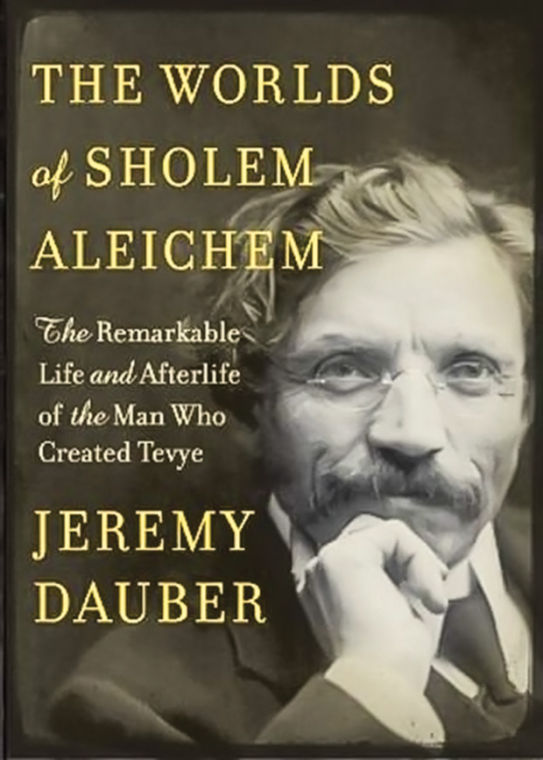Sholem Aleichem brought to life in definitive biography
Published April 23, 2014
Jeremy Dauber, a professor of Yiddish literature at Columbia University and director of its Institute for Jewish and Israel Studies, has written a splendid biography of Solomon Naumovich Rabinovich, better known under his pen name Sholem Aleichem.
“The Worlds of Sholem Aleichem: The Remarkable Life and Afterlife of the Man Who Created Tevye” (Shocken Books, $28.95, 448 pages), is the 22nd in a Jewish Encounters series, a project devoted to the promotion of Jewish literature, culture and ideas. Dauber has written what has been hailed as the first comprehensive biography of Sholem Aleichem in any language.
Sholem Aleichem (1859-1916), a novelist, playwright, journalist, essayist and editor, was born in what today is central Ukraine. He is considered one of the founding giants of modern Yiddish literature. He produced more than 40 volumes in Yiddish, becoming a central figure in Yiddish literature by 1890.
ADVERTISEMENT
For years, Yiddish was the vernacular of nearly all literate East European Jews despite being condemned by many as nothing more than jargon. Aleichem was an impassioned advocate of Yiddish as a national language, one that should be granted the same status and respect as other modern European languages.
Although he also knew Hebrew and Russian, he realized that Yiddish gave him access to a vast audience, and he gained great success throughout Europe and the United States.
Dauber skillfully emphasizes this choice in his biography and maintains that immigrants and children of immigrants turned to Aleichem and his stories for the tradition and nostalgia of the “old country.”
ADVERTISEMENT
Aleichem was often referred to as the Jewish Mark Twain because of the two authors’ similar writing styles and the use of pen names. Both wrote for adults and children, and both lectured extensively in Europe and the United States. When Twain heard Aleichem called the Jewish Mark Twain, he said, “Please tell him that I am the American Sholem Aleichem.”
Aleichem’s characters are familiar to thousands and have been made immortal in books and plays. They include Motl, an orphan who travels with his mother and older brother to America from a shtetl in Europe; Menakhem Mendl, a ne’er-do-well financial speculator and his long-suffering wife; and the most familiar of all, Tevya, the milkman.
Dauber’s book is well researched, and his writing style is crisp, swift and clear. The book, which is aimed at a general, rather than a scholarly, audience, presents Aleichem’s legacy through the lens of his very chaotic life.
Dauber has constructed his book in an unusual manner, much akin to a Playbill in a Broadway show. In the overture, Dauber “sets the play.” This is followed by four acts in which Dauber chronologically traces Aleichem’s life. All the chapters in these four acts begin with the words “In Which Our Hero …”
It is no accident that the descriptive chapter titles are exactly in the style of Sholem Aleichem.
The book ends with an epilogue that Dauber calls “An Afterlife in Ten Scenes,” composed of 10 scenes beginning in 1916 and ending in 2013. This construction accounts for the book’s briskness and helps holds the reader’s interest.
Dauber is a scholar of modern Jewish literature, so he placed his biography of Aleichem within literary and historical contexts. His excellent bibliography indicates that he referred primarily to the actual works of Alechiem, which dealt with the Jews living in the Pale, a vast territorial ghetto where the Russian Empire confined its Jews.
At the end of the 19th century, life for the Jews changed with the assassination of Czar Alexander II. This led to mass emigration of more than 2 million Jews, mostly to America. Religious practice was declining, and religious beliefs were fading. Socialism and secularism were enticing the Jews, and Aleichem, never an observant Jew himself, saw and wrote it all because he lived it all.
Dauber’s emphasis on the literary context results in the book’s only weakness: It lacks information about Aleichem’s family or his private life. He was one of eight children, but there is little information about his siblings. He enjoyed a happy marriage to Olga Loyeff, who bore him four daughters and two sons, yet Dauber hardly mentions his relationship with either Olga or their children. Their daughter Marouisse is mentioned only when she marries, and their son Misha is briefly discussed later in the book but only to report that he died of tuberculosis.
Halfway through the book, Dauber mentions that Aleichem’s “complex relationship with Misha, as with many of his growing and grown children, was full of opposing impulses,” but he doesn’t explain it.
Despite this lack of information, Dauber’s book should be of interest to the academic as well as the general reader. He has brought his subject to life.
















